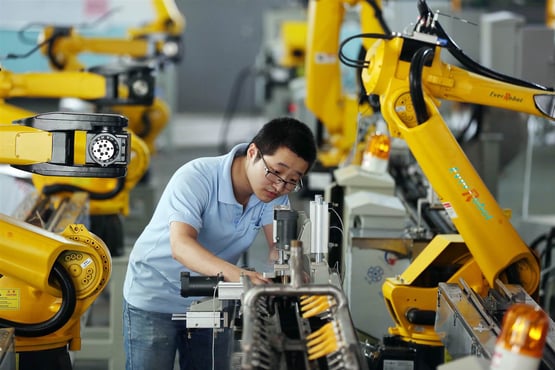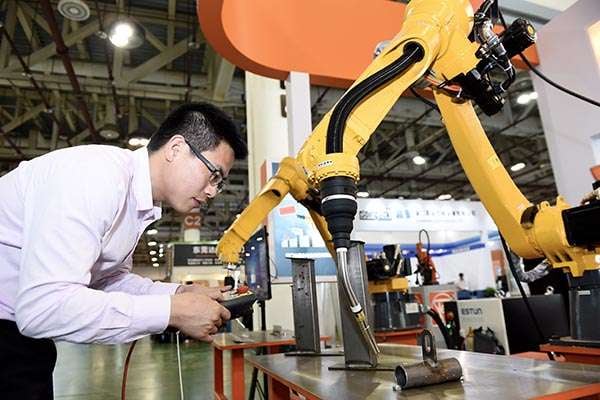What Direction Is Robotics Heading?

The new Robotics Roadmap indicates future directions of the field. What has changed in the last four years? Where is robotics heading?
The US Robotics Roadmap is a report published by an American network called Robotics Virtual Organization. Originally funded by the National Science Foundation, they coordinate special interest groups within the various fields of robotics and report on the state of the robotics industry.
Past versions of the Roadmap were published in 2009 and 2013. The latest was published in November 2016.
Although the report focuses on the USA, it is a good indicator of the general directions of the industry worldwide. Robotics is truly a global industry and many of the trends are reflected internationally.
In the last four years, the robotics industry has noticeably changed. In this article, we compare the new 2016 Roadmap with the previous 2013 Roadmap to ask: Where is robotics headed?
General Overview: Robotics Goes Mainstream
Overall, the new Roadmap feels more mature — to me — than the previous versions. It now feels like robotics is trying to move out of research institutes and connect with the wider society. How much this actually happens remains to be seen. The report is largely produced by universities and the non-academic voices are noticeable in their absence. However, the Roadmap does appear to have changed direction since the previous version.
The 2013 version mostly listed new avenues of research. In contrast, the 2016 version is trying to address real-world problems.
This is most clear in the restructuring of the report. While much of the content remains the same, it has been heavily reorganized. Several new sections have been added. This reflects more than a mere editorial decision; it feels like a change of mindset.
The titles of sections have become more society-centric. For example, the previous section "Roadmap for Healthcare and Medical Robotics" has been replaced by "Health, Independence And Quality Of Life," showing an understanding of the healthcare needs of society.
This new, society-centric approach is also reflected strongly in the in new "Legal, Ethical, and Economic Context" section. In it, the authors explain this change of mindset:
The Roadmap to Robotics is primarily a technical document. […] It is clear to the authors, however, that the development of robotics in the United States and elsewhere takes place against a backdrop of law, policy, ethics, and economics—among other social, cultural, and political forces.
As we have discussed before on the Robotiq blog, robotics and society are at a decisive moment in history.
Four Key Changes in the Last Four Years
The report addresses areas of robotics separately and manufacturing remains a important section of the Roadmap. While much of the content has remained the same since 2013, here are four key changes in the 2016 version.
1. Slower but Steady Growth
One dramatic change is the drop in growth rate in almost all manufacturing industries since the last Roadmap. The average yearly growth rates have fallen significantly, probably the result of the global financial crash (as the 2013 report used averaged data from 2004-2011). The manufacturing sector is still growing, but much slower than it was.
In terms of GDP, the manufacturing sector in the US has decreased slightly in the last four years. In 2013 it represented 14% of the country's GDP and 11% of its total employment. In 2016 this has fallen to 12% of the GDP and 9% of total employment.
In contrast, however, the robotics industry has grown. In 2013, the robotics industry in the US was worth $5B. In 2016, this grew to $8B, with the sector growing at a steady 9% every year.
2. Japan and China Step Up
Also noticeable is the increased presence of Japan and China in the manufacturing sector and industrial robotic sector.
Although Japan has long been a player in social robotics, it recently staked a claim in industrial robotics. In 2016 it announced "a major push to become leader in robotics with a 5 year investment of $1B for industrial robotics."
China's presence also features strongly in the Roadmap. It says:
"Right now China is considered the manufacturing leader, but USA is expected to overtake China by 2020 in terms of manufacturing both in terms of value and productivity."
With the current drive to inshore manufacturing back to the US, robotics will play a huge role in meeting this goal. I imagine that other countries will also follow suit.
3. Legal and Ethical Concerns for the Industry
As we discussed recently, the legal aspects of robotics received a large push last year by politicians and industry leaders. The new legal and ethical section of the Roadmap reflects this change.
The section discusses safety concerns, legal liability, security, privacy and impact on labor. Although the section is currently short, it is a sign of changing times.
The authors make recommendations for:
- Greater expertise in robotics in government, to maximize the potential of robotics.
- Support of interdisciplinary research, including both academia and government [and industry, I would add].
- Removal of legal research barriers regarding accountability and safety testing of robots.
The section only provides a cursory look at these issues and much more could be included. It will be interesting to see how it develops in the next Robotics Roadmap four years from now.
4. Shared Infrastructure in Robotics and Education
Two more new sections were added to the Roadmap in 2016:
- Workforce Development — This section discusses workforce education in robotics and also calls for the introduction of career paths for young people.
- Shared Infrastructure In Robotics — This section discusses the need for more standardized robot testbeds to aid both research and education of future robotics professionals.
Both of these new sections represent a growing recognition within the robotics community that proactive training is vital to prepare the workforce for robots. It is no longer sufficient to simply provide better technology.
What's Next for Robotics?
Progress in robotics is — relatively speaking — a slow process and only four years has passed since the previous US Robotics Roadmap.
Even so, there is a clear change of direction in the new Roadmap since the 2013 version. We are now entering a period where robotics and society meet head on. Big decisions are already starting to be made on how robotics will integrate with the world outside of research.
The needs of society are changing and the robotics industry is preparing itself to respond to those needs.
How do you think robotics will change over the next four years? What new trends should we look out for? What do you think of the new US Robotics Roadmap? Tell us in the comments below or join the discussion on LinkedIn, Twitter, Facebook or the DoF professional robotics community.








Leave a comment